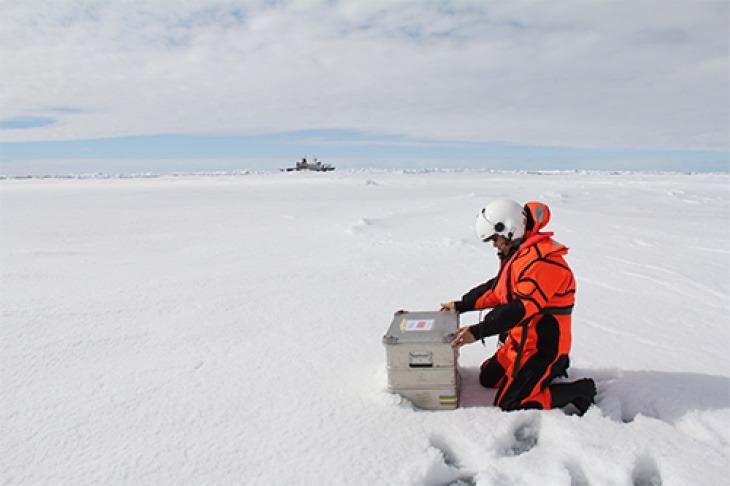In the early 2000s, flame-retardant materials called PBDEs were successfully banned; however, it got substituted by another challenging chemical series termed organophosphate esters (OPEs).

Image Credit: Hereon/ Zhiyong Xie
Since then the application of OPEs grew greatly, without awareness of their effects on the environment. The scientists examined the conveyance and existence of OPEs and put them into context concerning their possible dangers to humans and organisms. Zhiyong Xie from Helmholtz-Zentrum Hereon’s Institute of Coastal Environmental Chemistry directed an international team and recently studied OPEs in international oceans.
The research has been published in the March 23rd issue of the Nature Reviews Earth & Environment journal.
Besides industry, organophosphate esters (OPEs) are regularly found in daily products such as household consumer products, electronics and cosmetics. OPEs work mainly as plasticizers and flame-retardants.
At present, OPEs are found in seawater, the air, sediments, snow and even amassed in aquatic mammals and organisms in Polar regions. The team was able to establish the occurrence and dispersal of OPEs from inland sources (like surface water, wastewater and e-waste) to coastal locations in North America, Europe and Asia.
The moving ocean currents and air masses move OPEs from industrialized and populated areas to the open ocean. Higher concentrations were also seen in the Arctic and areas far from shore.
Although there are not many studies that evaluate the health impacts and toxicity of OPEs in sea organisms, lab experiments have established that certain OPEs can be carcinogenic and neurotoxic. They can have harmful effects on hormonal balance, genetic constitution and reproduction.
When we eliminate one toxic substance we shouldn’t take another toxic one to cause new problems. We should think about a replacement for any kind of toxic substance. Hence, we need to search for less toxic ones, that are environmentally friendly.
Zhiyong Xie, Study Lead, Institute of Coastal Environmental Chemistry, Helmholtz-Zentrum Hereon
OPEs in the Environment
Due to the wide presence of OPEs in the oceanic atmosphere and biota, the harmful effects of the substance group on organisms were observed. Primarily, there is a disrupting impact on the photosynthesis of some algae species and their population growth. Secondly, the immune system of oceanic mussels exposed to OPEs is disrupted.
There are indications that OPEs are photodegradable in seawater and their decayed products were detected in polar bears and fish from the sea, which are in the highest predator position in the Arctic oceanic food web.
The need for appropriate data and improved research also increases due to the fact, that OPEs are resolutely incorporated into everyday products. Health effects particularly for children are rarely identified and the detected concentrations seem to be in magnitudes of tons each year, which is astonishingly high.
Since these artificial organic chemicals are largely used in plastic products, OPEs are discharged through volatilization, abrasion and leaching. Additionally, they are described by resistance and mobility in the water, although it has to be distinguished between chlorinated and non-chlorinated OPEs. The former is even more persistent, very mobile and more lethal.
From terrestrial sources, rivers like the Rhine carry these pollutants into coastal areas from where they move within the ocean circulation and show up even in remote places like the Arctic. The atmosphere works analog to this ocean voyage as a conveyance service for the chemicals.
The Risk of Climate Change
Significant concentrations of OPEs have been trapped in the earth’s frozen environs, known as the cryosphere. Global warming and thus melting ice shields, permafrost throwing and glacier retreat will increase the relative copiousness and concentration of OPEs in the marine system with likely effects on ocean health.
The research aimed to back the thesis of newly created issues that perhaps arise with continuing climate change, states Zhiyong Xie.
Governmental Lack
There is barely any global regulation to tackle the increasing OPE concentrations. At the Stockholm convention, the Persistent Organic Pollutants (POP) Review Committee published a list of targeted chemicals. It aims to decrease these chemicals and eventually eradicate them from the environment.
However, they are not associated with OPEs.
There are OPEs which are 100 times higher in the abundant concentration, than some of the listed substances which are targeted from now on.
Zhiyong Xie, Study Lead, Institute of Coastal Environmental Chemistry, Helmholtz-Zentrum Hereon
He states that by publishing this research, they hope to garner attention to the OPEs and to add them to the list for risk management evaluation of chemicals.
The researchers emphasize the need for immediate regulation toward a global production halt of OPEs. The research also highlights the imperative need for safer and less toxic substitutes of flame-retardants, so as to “avoid regrettable substitutions”.
Journal Reference:
Xie, Z., et al. (2022) Organophosphate ester pollution in the oceans. Nature Reviews Earth & Environment. doi.org/10.1038/s43017-022-00277-w.